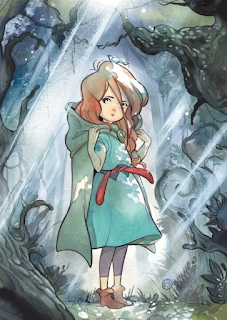In any world there are two absolutes: one is that a sheltered girl on the cusp of becoming a young woman is a headstrong, passionate creature and the other is that if a boy tells said girl she can't do something, she's going to walk through hellfire to prove him wrong. So can anyone really be surprised when Saoirse defies her father's wishes on her twelfth birthday and sets off to find the rumored witch's tower that hovers somewhere just outside of the safety of her village? With her sick brother in tow, and whispers of caution from her Nan, the girl with a strange mark on her should is about to begin a journey of magic, mystery, and more than a little danger in this debut issue of The Last Witch.
But will her fierce heart be enough to protect them from the darkness awaiting them on the brightest day of the year?
Conor McCreery brings The Last Witch to life in a quiet story that focuses heavily on the relationships between characters and the oldest trick in the parenting book - tales of things that gobble up little children who don't stay within the confines of the safety of their homes. While it sounds, on the surface, to be a formulaic fantasy epic, it was still refreshingly engaging and kept my attention to the last panel. I'm a fan of character-driven stories and I'm really happy that McCreery has steered The Last Witch in a direction that relies on Saoirse and the legend of a witch rather than flashy scenes. As someone with children, and both an older and younger sister, I felt like the relationship with Saoirse and her brother, Brahm, was really accurate, especially in the way they spoke to each other rather than to the adults in their lives.
One of the most impressive bits of art was, for me, the snow. There's a lot of it in The Last Witch and all that white can be intimidating for a lesser artist but Glass does a good job of showing depth and variation in the snow shots. It is worth noting, almost necessary even, that the artwork may be beautifully done but it's taken to the next level from the colors.
The Last Witch, like many character-driven stories with family-centric plots, is a bit heavy on the dialogue. It isn't a negative and I think it works in this instance for the worldbuilding McCreery has started. But it can be a bit tricky to read at times and I have found that most letterers have a hard time fitting in the appropriate word balloons without dominating panels.
The Last Witch was an inviting welcome into Saoirse's world and an extended hand to join her as she rebels her way into trouble like she's never known before. It may have followed a pretty basic story formula but in a way that felt like an old friend and I can't wait to find out what happens next. There's a light tone of foreboding in the last few pages of the issue that makes me think that the writing formula is going to get tossed out the window, along with my expectations, and there's nothing more exciting than not knowing what's just over the hill.









![Sweat and Soap [Ase to Sekken] by Kintetsu Yamada](https://blogger.googleusercontent.com/img/b/R29vZ2xl/AVvXsEgMnQltxjWqGS1_duhCp9Er1a0NbALuSFrqvjaV4_PjN_w67xCGghYt-l0qKyqTH7Ei7gbq_mxVq8aPAuOiyaArwAMLJWhpGmOYaARUBnwvjmv2-ZIe20m_zR5CvKnPdI6US_AuOnmi3gSX/w680/57525895-BA7E-4EF8-9FE4-89F9C164E1A4.jpeg)

